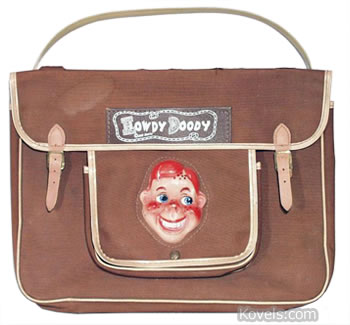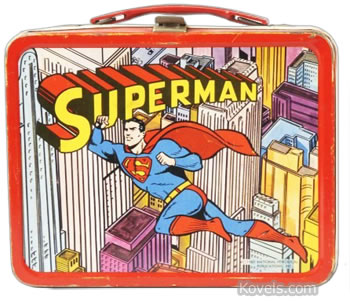Remember your first school days? Mom got you the “in” equipment to make you more comfortable. Today it would be a backpack, cell phone, and calculator. But what was it like in the past? What are the most important items from your parent’s or grandparent’s day that won’t be going to school this year? Terry Kovel gives the five top items:
1) A Crooked Hip or a Book Bag
In the 1890s, most children took a book, a slate (then homemade; now $75) and a pencil. In the 1940s, those in the know carried a pile of books resting on one hip. Years later, that lopsided hip meant that alterations were needed to get a straight hem on a dress. The tote bag a or book bag (97¢ in 1945; $10 for a vintage one on eBay)—the name depended on what part of the country you lived in—started in the 1950s and continued into the ‘70s, when good posture was stressed. The bag held books, homework, pens and pencils. Some bags were carried dangling from a string handle. The backpack is a 1980s idea that replaced the tote—and the pile of books on the hip. Maybe by 2015 it will be just an iPad loaded with books, homework, an encyclopedia and much more. Some schools are using them now. (Howdy Doody bookbag photo courtesy of Lloyd Ralston Gallery.)
2) Metal Lunch Box
Metal lunch boxes went to work each day filled with a homemade sandwich and pie. Carpenters, farmers, and other laborers used the tin boxes in the 19th century. The boxes were often part of a selling promotion for loose tobacco. The tobacco company’s logo was printed for all to see and the lunch box was waterproof, lightweight, and free. Paper bags, previously loaded with groceries, were being used by children by the 1920s. In 1950 the first modern metal lunch box was made with a picture of Hopalong Cassidy on the front ($2.39 new). It looked like a little metal suitcase with a handle. The last metal lunch box was made in 1985 with a picture of Sylvester Stallone as Rambo on the cover. (Record price for a metal lunch box that pictured Superman sold for $13,225.) Metal lunch boxes reportedly lost favor when a boy hit a classmate with his lunch box and caused serious injury. So some schools outlawed the boxes as “weapons” and plastic and vinyl lunch boxes came into fashion. (Superman lunch box photo courtesy of Morphy Auctions.)
3) Fountain Pen
It is said that New York insurance salesman, Lewis Edson Waterman, gave a paper insurance policy to a prospective customer. Then he loaned the customer a new reservoir ink pen to use to sign the policy. The pen left an ink blot on the policy and the superstitious customer thought it was a sign of bad luck. He did not sign the contract. Waterman worked on the problem and invented the first practical fountain pen in the 1880s. It soon replaced the sharpened quill as a writing device. Owning a good fountain pen in the early 1900s was a sign of a man’s achievement. Most had gold tips. Some were made of newly created plastic or hard black rubber ($1.25 in 1927; now $200 to $300). The ballpoint pen was invented in 1945 and replaced the fountain pen in schools. (Waterman fountain pen photo courtesy of Gorringes, Lewes, England.)
4) Wristwatch
The wristwatch became popular among soldiers during World War I and was soon a necessary piece of jewelry. Every student wanted a wristwatch (about $2) to see how many minutes of class remained. The cell phone became a school-supply requirement in about 2005, because parents wanted to call kids to arrange pickups or change appointments. Since the cell phone displays the time, wristwatches went out of style. But they are coming back again in 2012 because cell phones are locked away during the school day in many schools. Wristwatches have new designs and are fashionable jewelry ($25 to $200 plus). They’re bigger, brighter and have more special features—and they still tell time. (Contemporary wristwatch photo courtesy of Spiceytec.com.)
5) Slide Rule
Slide rules were the computing tool of the past. William Oughtred and others developed the slide rule in the 17th century. It was used by scientists and engineers. Every high school student taking advanced math in the 1900s needed a slide rule ($6.25 in 1922; $35 to $75 for vintage examples). Most were made of wood, but a few expensive ones were ivory. The use of slide rules grew until about 1974, when the first electronic calculator was put on the market by Texas Instruments. A good calculator was very expensive. In 1975 a calculator for a college course cost $400. Tuition for a year at college then averaged about $5,000. Today it is hard to find anyone who knows how to use the old slide rules. Electronic devices do it all. (Slide rule photo courtesy of Universal Live.)
Find prices of all sorts of school-related items in the free online price guide at Kovels.com







Leave a Reply
You must be logged in to post a comment.